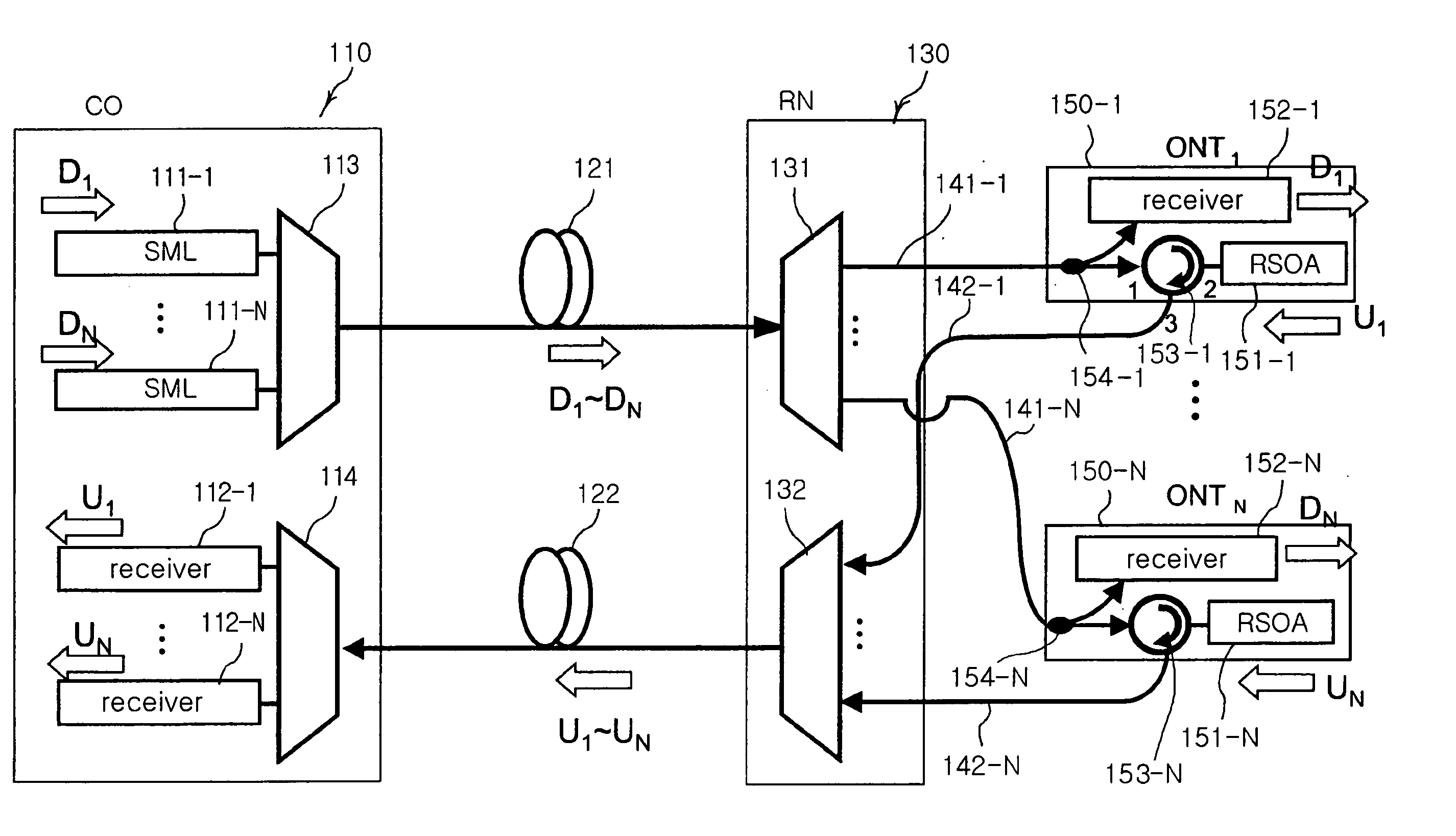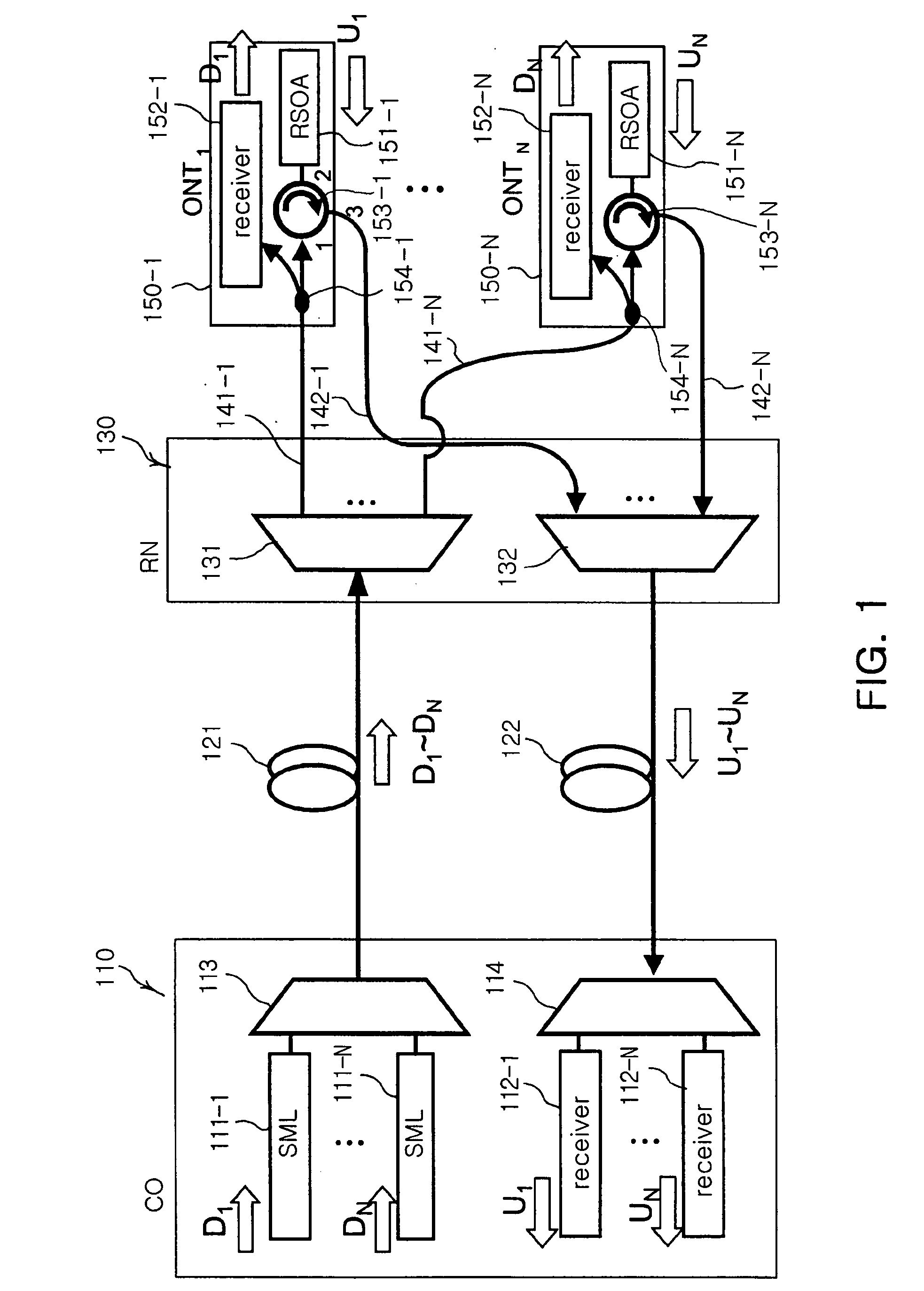Loop-back wavelength division multiplexing passive optical network
a passive optical network and wavelength division technology, applied in the field of wavelength division multiplexing passive optical network, can solve the problems of difficulty in providing a quality-guaranteed wide bandwidth of more than 100 mb/s to subscribers, difficulty in deployment, and difficulty in providing such dsl and cmts technologies with bandwidth and quality assurance, and achieves the effect of reducing power loss and simple structur
- Summary
- Abstract
- Description
- Claims
- Application Information
AI Technical Summary
Benefits of technology
Problems solved by technology
Method used
Image
Examples
first embodiment
[0033]FIG. 1 is a diagram illustrating the configuration of a loop-back WDM-PON according to the present invention.
[0034] Referring to FIG. 1, an RSOA-based loop-back WDM-PON system according to the first embodiment of the present invention includes a central office (CO) 110, upstream and downstream optical fibers 121 and 122, a remote node (RN) 130, downstream signal optical fibers 141-1 to 141-N, upstream signal optical fibers 142-1 to 142-N, and optical network terminals (ONTs) 150-1 to 150-N.
[0035] The central office 110 includes light sources 111-1 to 111-N, central office receivers 112-1 to 112-N, a central office optical multiplexer 113, and a central office optical demultiplexer 114. For example, Single Mode Laser diodes (SMLDs), such as Distributed Feedback Laser Diodes (DFB-LDs), may be used as the light sources 111-1 to 111-N, and are constructed separately or in an integrated array form. The lights of single mode laser diodes, having N wavelengths that are assigned to t...
second embodiment
[0050]FIG. 4 is a diagram illustrating the configuration of a loop-back WDM-PON according to the present invention.
[0051] The loop-back WDM-PON according to the first embodiment of the present invention, which is shown in FIG. 1, has a structure in which the optical network terminals 150-1 to 150-N are provided with the couplers 154-1 to 154-N and the circulators 153-1 to 153-N, respectively, so that it is relatively expensive and has a somewhat complicated structure. In contrast, in the loop-back WDM-PON according to the second embodiment of the present invention, a coupler 134 and a circulator 133 are positioned in a remote node 130 and shared by subscribers, thus resulting in a structure that reduces the cost and complexity of constructing a network.
[0052] Referring to FIG. 4, in the loop-back WDM-PON according to the second embodiment of the present invention, a multiplexed downstream signal is input from a central office 110 to the remote node 130 through a downstream optical ...
third embodiment
[0054]FIG. 5 is a diagram illustrating the configuration of a loop-back WDM-PON according to the present invention.
[0055] The loop-back WDM-PON according to the second embodiment of the present invention, which is shown in FIG. 4, has a structure in which the upstream optical fiber 121 and the downstream optical fiber 122 are separately used, whereas the loop-back WDM-PON according to the third embodiment of the present invention is constructed to transmit both an upstream signal and a downstream signal through a single optical fiber.
[0056] Referring to FIG. 5, in the loop-back WDM-PON according to the third embodiment of the present invention, a circulator 115 is positioned in a central office 115, and a coupler 134 is positioned in a remote node 130. The outputs of single mode light sources 111-1 to 111-N modulated to a downstream signal in the central office 110 are multiplexed by an optical multiplexer 113, and input to the remote node 130 through the circulator 115 and an upst...
PUM
 Login to View More
Login to View More Abstract
Description
Claims
Application Information
 Login to View More
Login to View More - R&D
- Intellectual Property
- Life Sciences
- Materials
- Tech Scout
- Unparalleled Data Quality
- Higher Quality Content
- 60% Fewer Hallucinations
Browse by: Latest US Patents, China's latest patents, Technical Efficacy Thesaurus, Application Domain, Technology Topic, Popular Technical Reports.
© 2025 PatSnap. All rights reserved.Legal|Privacy policy|Modern Slavery Act Transparency Statement|Sitemap|About US| Contact US: help@patsnap.com



